Effects of Uplift Resistance on Continuous-Pipe-Foundation of Single-Span Plastic Greenhouse by Steel Plate Pipe Connector
Abstract
:1. Introduction
2. Materials and Methods
2.1. Sample Preparation
2.2. Field Test Condition
2.3. Field Test Method
2.4. Measured Uplift Resistance
3. Results
3.1. Results of Field Compaction on Site A, Site B, and Site C
3.2. Results of Field Test of Uplift Resistance on Site A, Site B, and Site C
3.3. Results of Uplift Resistance by Embedded Depth
3.4. Discussion of Test Results for Site A, Site B, and Site C
4. Conclusions
Funding
Institutional Review Board Statement
Data Availability Statement
Conflicts of Interest
References
- RDA. Development of Foundation Design Technology on Single Span Plastic Greenhouse According to Soil Property; Rural Development Administration: Jeonju, Korea, 2021. (In Korean) [Google Scholar]
- Ministry of Agriculture, Food and Rural Affairs (MAFRA). Present Condition of Vegetable Grown in Facilities and Vegetable Production Performance; Ministry of Agriculture, Food and Rural Affairs: Sejong City, Korea, 2018. (In Korean)
- Ministry for Food, Agriculture, Forestry and Fisheries (MIFAFF); Rural Development Administration (RDA). Designated Notice of Standards to Endure Disaster for Horticultural and Special Facilities; MIFAFF & RDA: Gwacheon and Suwon, Korea, 2014. (In Korean) [Google Scholar]
- Rural Development Administration (RDA). Symposium for Reducing of Meteorological Disasters of Agricultural Facilities; RDA: Suwon, Korea, 2007; pp. 160–161. (In Korean) [Google Scholar]
- MAFRA, Facility Vegetable Greenhouse Status and Vegetable Production Output Report, Ministry of Agriculture, Food and Rural Affairs. 2021, pp. 105–108. Available online: 2020%20%EC%8B%9C%EC%84%A4%EC%B1%84%EC%86%8C%20%EC%98%A8%EC%8B%A4%ED%98%84%ED%99%A9%20%EB%B0%8F%20%EC%B1%84%EC%86%8C%EB%A5%98%20%EC%83%9D%EC%82%B0%EC%8B%A4%EC%A0%81.pdf (accessed on 15 September 2022). (In Korean).
- Robertson, A.; Roux, P.; Gratraud, J.; Scarascia Mugnozza, G.; Castellano, S.; Dufresne de Virel, M.; Palier, P. Wind pressures on permeably and impermeably clad structures. J. Wind. Eng. Ind. Aerodyn. 2002, 90, 461–474. [Google Scholar] [CrossRef]
- Lee, S.G.; Lee, J.W.; Lee, H.W. Development of One-Span Vinyl House for Reduction of Damage by Heavy Snow. J. Bio-Environ. Control 2005, 14, 138–144. (In Korean) [Google Scholar]
- Lee, B.G.; Yun, S.W.; Choi, M.K.; Lee, S.Y.; Moon, S.D.; Yu, C.; Yoon, Y.C. Uplift Bearing Capacity of Spiral Steel Peg for the Single Span Greenhouse. J. Bio-Environ. Control 2014, 23, 109–115. (In Korean) [Google Scholar] [CrossRef]
- Lee, W.-G.; Woo, J.-H.; Lee, H.-D.; Shin, K.-J. Analysis of Uplift Capacity on Single-span Greenhouse’s Foundation According to Wind Load and Evaluation for Reinforcing Methods. J. Archit. Inst. Korea 2022, 24, 33–39. (In Korean) [Google Scholar]
- MOIS. Statistical Year Book; Ministry of the Interior and Safety: Sejong City, Korea, 2021. (In Korean)
- Ogawa, H.; Tsuge, I.; Sato, Y.; Hoshiba, S.; Yamashita, S. Experimental analysis on strength of pipe—House with Ground anchoring (II). J. Soc. Agric. Struct. 1990, 20, 262–269. [Google Scholar]
- RDA; NAAS; Department of Agricultural Engineering. Guide Book for Reduction of Meteorological Disaster of Agricultural Facilities; Rural Development Administration National Institute of Agricultural Sciences: Wanju-gun, Korea, 2007. (In Korean) [Google Scholar]
- Tanaka, H.; Fujikawa, M.; Matsuzaki, T.; Sumikawa, O.; Daikoku, M.; Inooku, K. Application of a screw type pile for the foundation of greenhouse. Misc. Pub. NARO. West. Reg. Agric. Res. Cent. 2005, 3, 21–37. [Google Scholar]
- Kim, M.K.; Nam, S.W.; Son, J.E.; Yun, N.K. Analyses of actual state and structural safety of regionally characterized greenhouse in Korean. Prot. Hortic. Plant Fact. 1994, 3, 128–135. (In Korean) [Google Scholar]
- Kim, M.K.; Nam, S.W. Experimental studies on the structural safety of pipe-houses. Prot. Hortic. Plant Fact. 1995, 4, 17–24. (In Korean) [Google Scholar]
- Cho, Y.S.; Kwon, O.Y. Uplift Capacity of a Single Screw Anchor. KSCE J. Civ. Eng. 1997, 17, 275–283. (In Korean) [Google Scholar]
- Lee, B.J.; Lee, J.K. A study on the critical embedment ratio of screw anchors. J. Ind. Sci. 1999, 6, 475–492. (In Korean) [Google Scholar]
- Yoon, Y.C.; Suh, W.M.; Cho, J.H. The uplift capacity of plane and corrugated piles for pipe frame greenhouse. Prot. Hortic. Plant Fact. 2001, 10, 148–154. (In Korean) [Google Scholar]
- Yoon, Y.C.; Lee, K.H.; Yu, C. A study on the uplift capacity improvement of pipe-framed greenhouse foundation using circular horizontal anchors. KCID J. 2003, 10, 55–61. (In Korean) [Google Scholar]
- Kim, D.H.; Yoo, C.S. Pull-out capacity of screw anchor pile in sand using reduced-scale model tests. J. KGS. 2013, 29, 121–133. (In Korean) [Google Scholar]
- Choi, M.K.; Yun, S.W.; Kim, H.N.; Lee, S.Y.; Kang, D.H.; Yoon., Y.C. Uplift capacity of spiral bar through the model experiment. Prot. Hortic. Plant Fact. 2015, 24, 202–209. (In Korean) [Google Scholar] [CrossRef]
- Yun, S.W.; Choi, M.K.; Lee, S.Y.; Yoon, Y.C. Uplift capacity of meteorological disaster. J. Agric. Life Sci. 2015, 49, 303–310. (In Korean) [Google Scholar] [CrossRef]
- Song, H.S.; Lim, S.Y.; Ryu, H.R. Slip-Resistance Test for Plastic Greenhouse Pipe Connectors According to Loading Rate. In Proceedings of the Korean Society of Agricultural Engineers Conference, Daejeon, Korea, 20 October 2016. [Google Scholar]
- Ding, L.; Zhang, S.; Wang, X.; Yang, X.; Zhang, C.; Qi, Y.; Guo, X. The occurrence and distribution characteristics of microplastics in the agricultural soils of Shaanxi Province in north-western China. Sci. Total Environ. 2020, 720, 137525. [Google Scholar] [CrossRef]
- Korean Statistics Information Service, Production of Agricultural Waste Vinyl 2004–2020, Last Modified 03-282020. 2020. Available online: https://kosis.kr/statHtml/statHtml.do?orgId=392&tblId=DT_AGRI01&vw_cd=MT_ZTITLE&list_id=T_20&seqNo=&lang_mode=ko&language=kor&obj_var_id=&itm_id=&conn_path=MT_ZTITLE (accessed on 15 September 2022). (In Korean).
- Heo, J.; Knag, C.Y.; Kim, D.W.; Kim, N.Y.; Gi, Y. Public Promotion Measures on the Adequate Disposal of Waste Agricultural Plastics and Collection Enhancement; Korea Rural Economic Iistitute: Naju-si, Korea, 2002. (In Korean) [Google Scholar]
- Lee, S.G. Development of Small Scale Vinyl House Model for Reduction of Damage by Wind and Show; National Research Foundation of Korea: Taejon-jikhalsi, Korea, 2004. (In Korean) [Google Scholar]
- JS F 1821; Uplift Load Testing Method of Piles. Japanese Society of Soil Mechanics and Foundation Engineering. The Japanese Society of Soil Mechanics and Foundation Engineering. National Research Foundation of Korea: Taejon-jikhalsi, Korea, 1992; pp. 1821–1989.
- ASTM D 3689-07; Standard Test Methods for Deep Foundations under Static Axial Tensile Load. ASTM International: West Conshohocken, PA, USA, 2010.
- Butler, H.D.; Hoy, H.E. User’s Manual for the Texas Quick-Load Method for Foundation Load Testing; FHWA-IP-77-8; FHWA: Washington, DC, USA, 1997.
- FHWA. Design and Construction of Driven Pile Foundations. Workshop Manual; National Highway Institute: Arlington, VA, USA, 1997; Volumes I, FHWA-HI-97-013. [Google Scholar]
- AbdelSalam, S.S.; Anwar, M.B.; Esmail, D.I. LRFD for Shallow Foundations Using Plate Load Test Data; Geo-Congress: Minneapolis, MN, USA, 2020; pp. 1–11. [Google Scholar]
- Lee, S.H.; Shin, K.J. Slip Test of Pipe Connector for Greenhouse Frame. J. Archit. Inst. Korea Struct. Constr. 2014, 30, 9–17. (In Korean) [Google Scholar] [CrossRef]
- Faizi, K.; Jahed Armaghani, D.; Momeni, E.; Nazir, R.; Mohamad, E.T. Uplift Resistance of Buried Pipelines Enhanced by geogrid. Soil Mech. Found. Eng. 2014, 51, 188–195. [Google Scholar] [CrossRef]
- Wu, J.; Kouretzisa, G.; Suwala, L.; Ansaria, Y.; Scott, W.S. Shallow and deep failure mechanisms during uplift and lateral dragging of buried pipes in sand. Can. Geotech. J. 2019, 27, 1–17. [Google Scholar] [CrossRef]
- Lee, S.I. The Farmers Newspaper. 2013. Available online: https://www.nongmin.com/plan/PLN/SRS/77249/view (accessed on 16 November 2022).

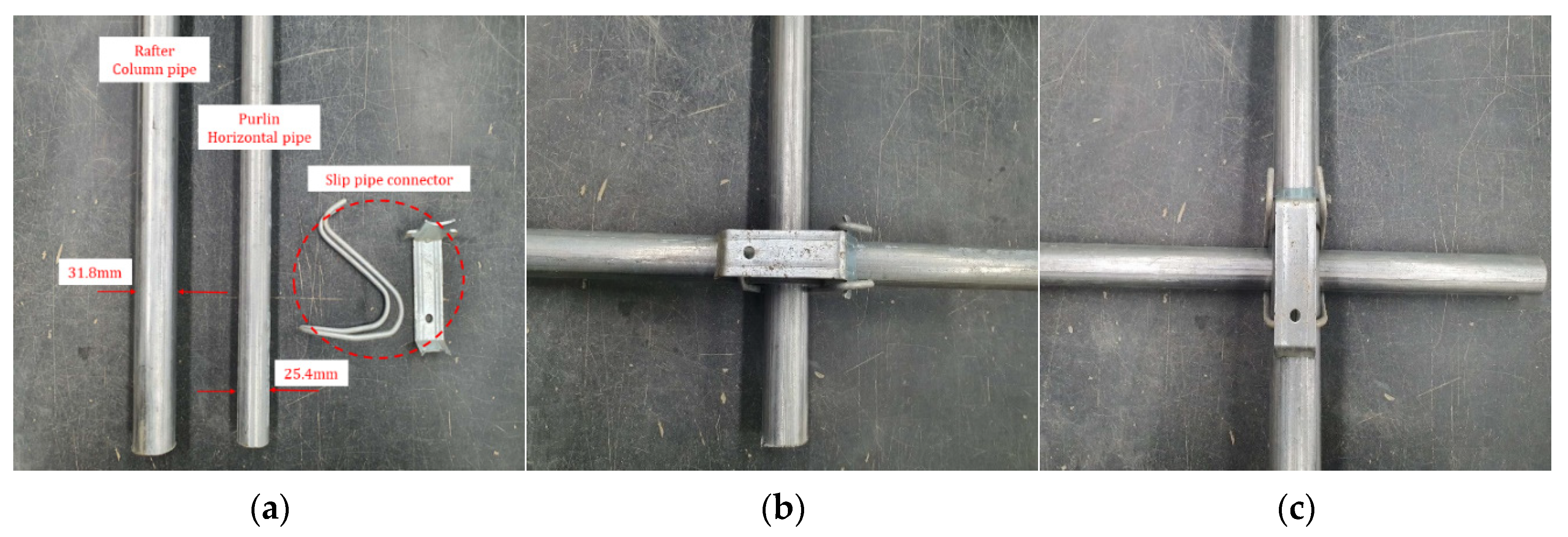


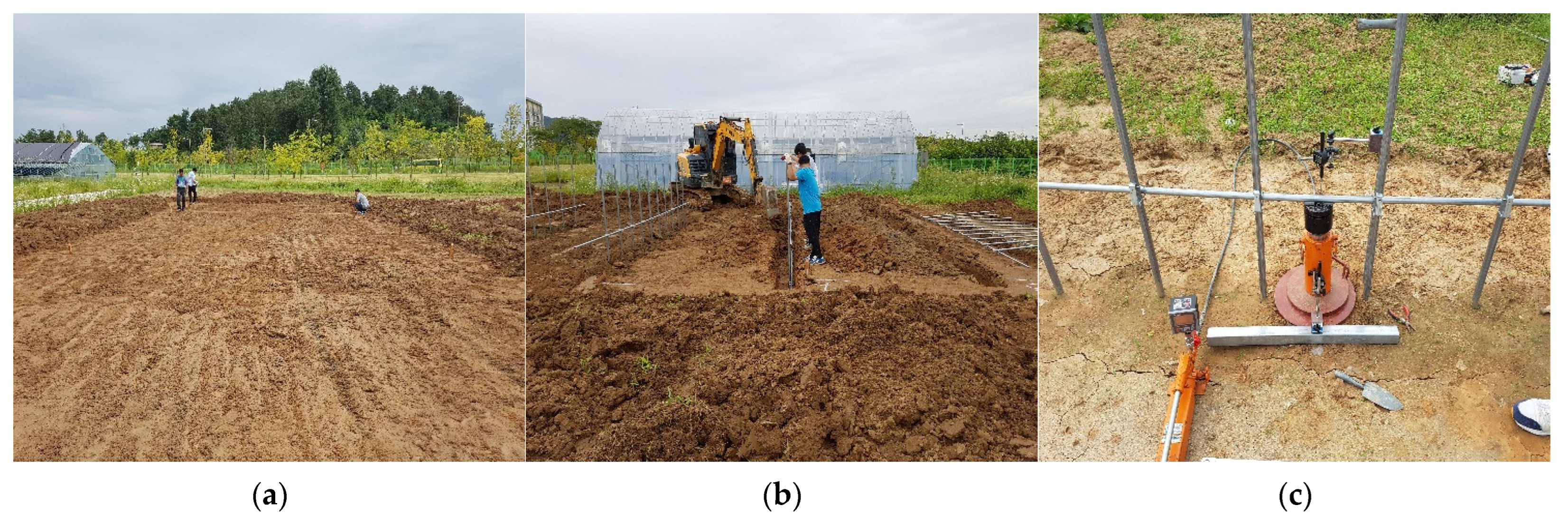

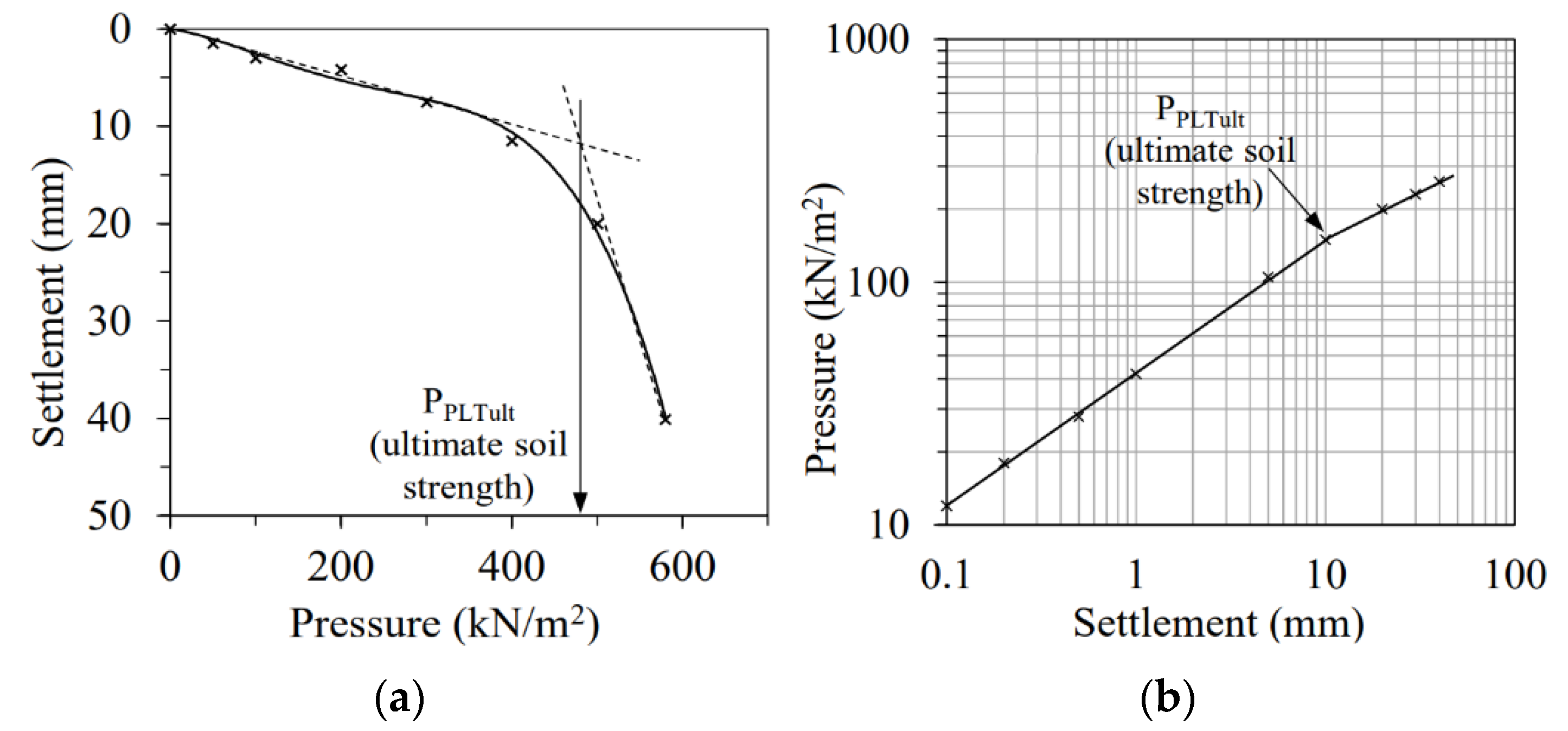
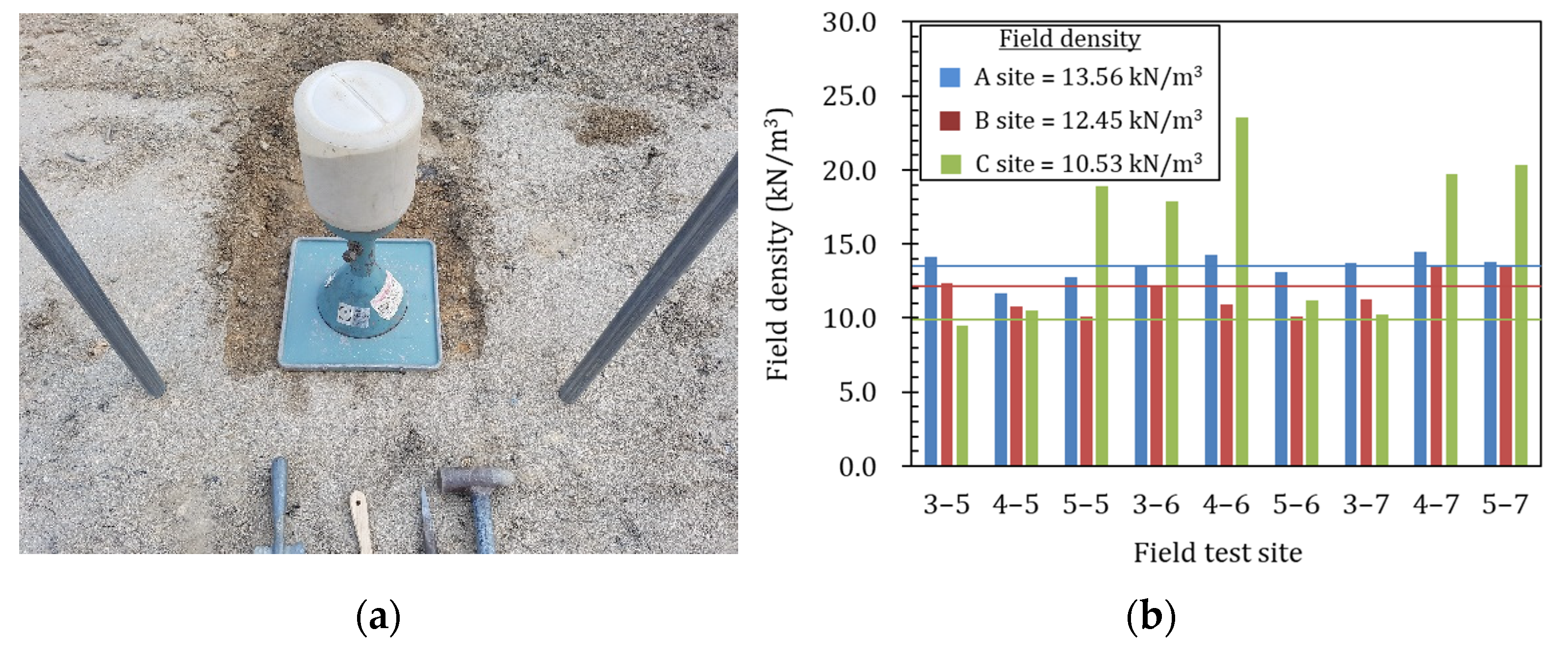
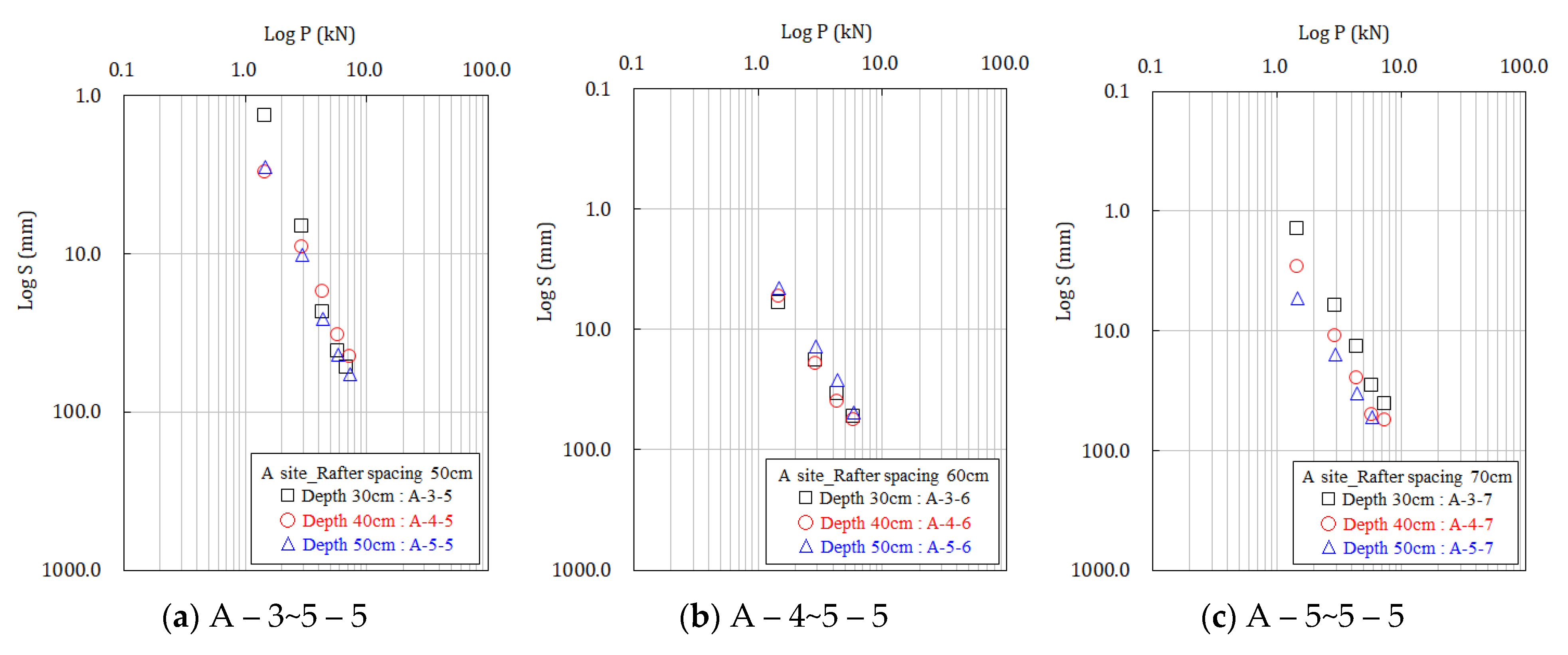
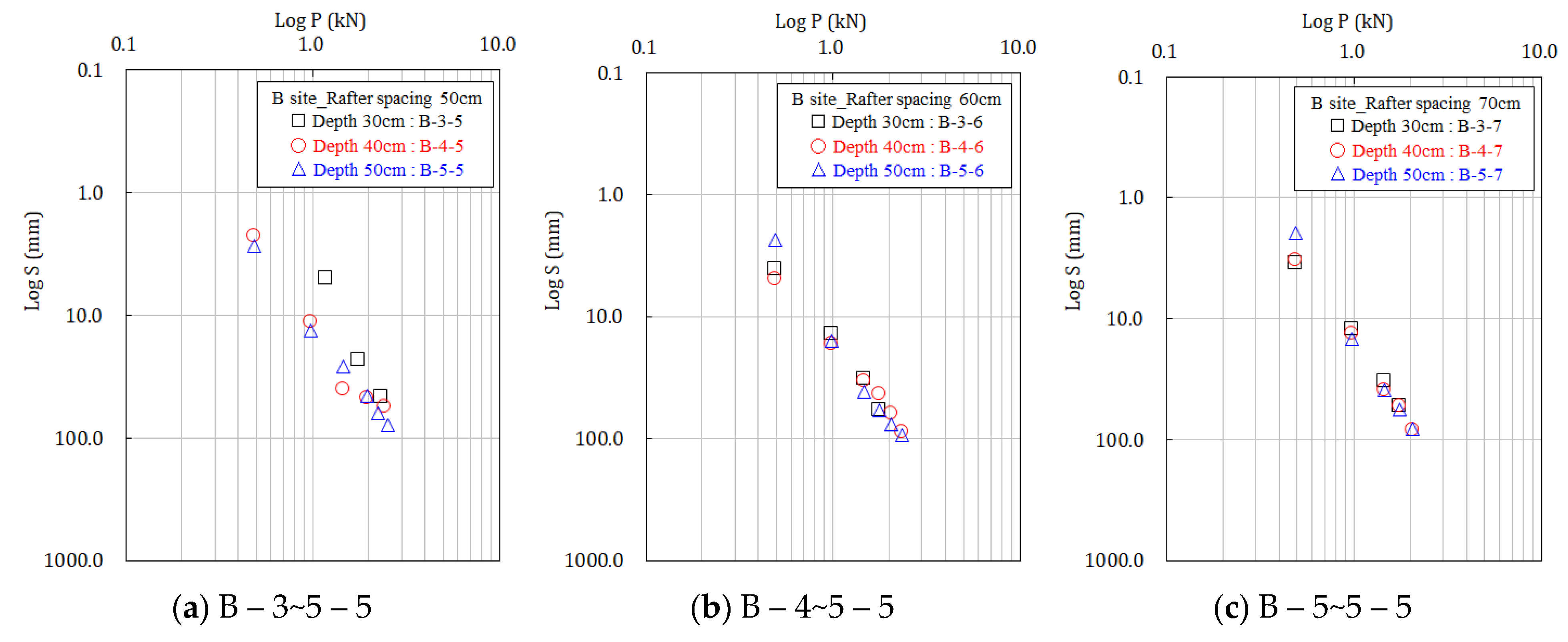
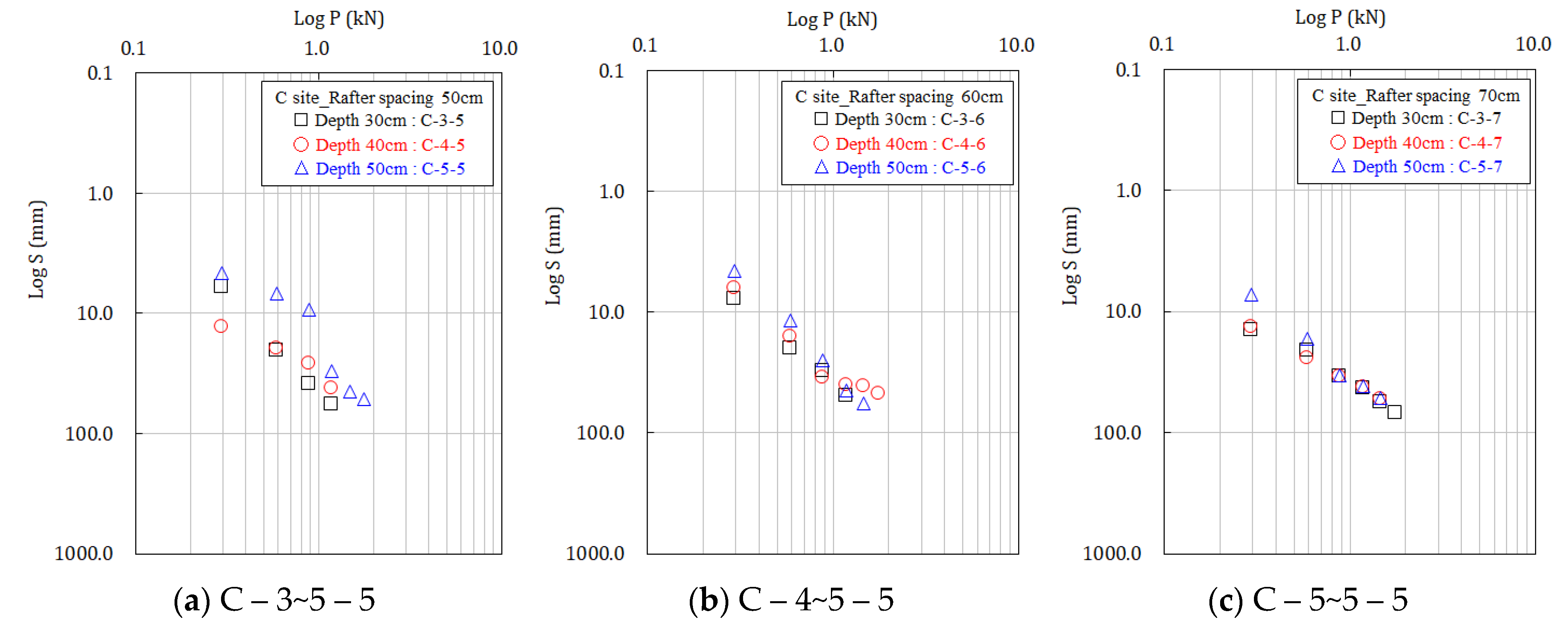

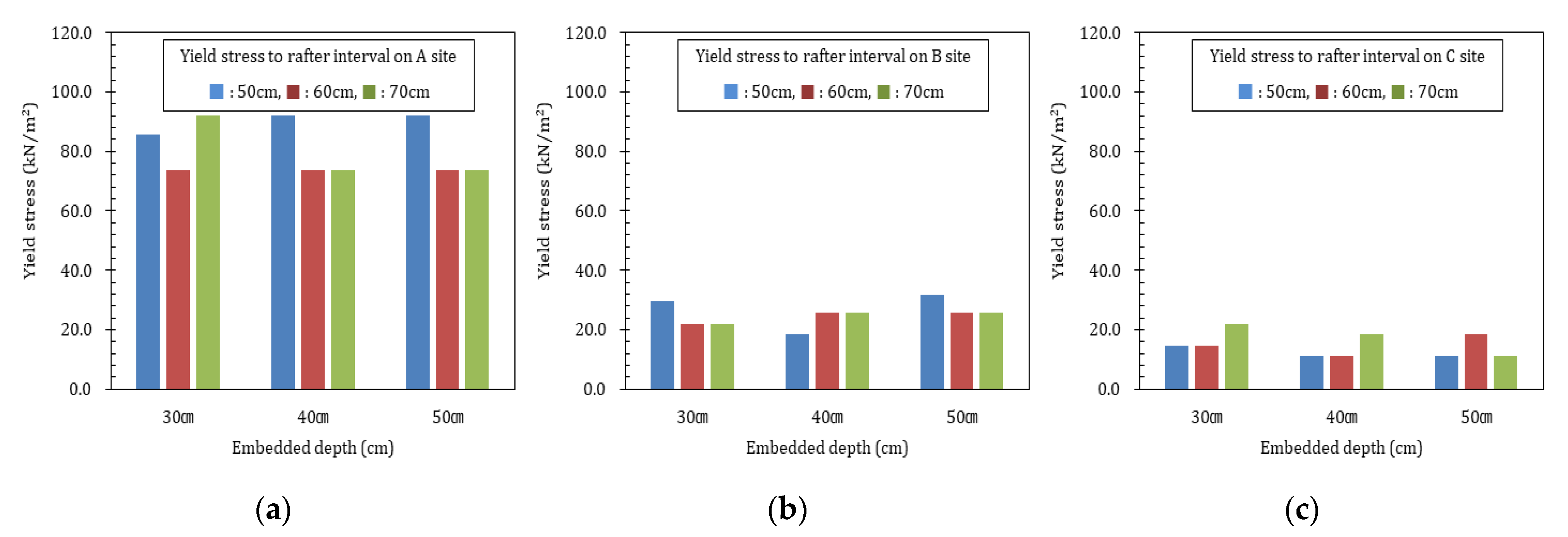
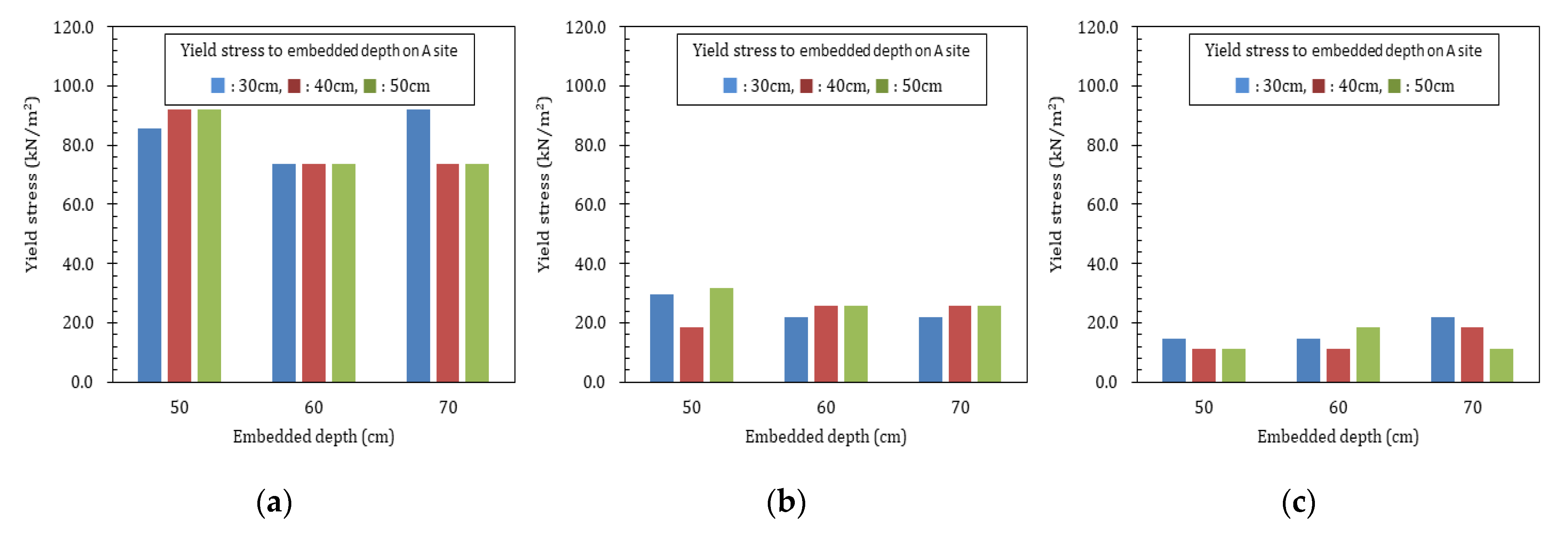
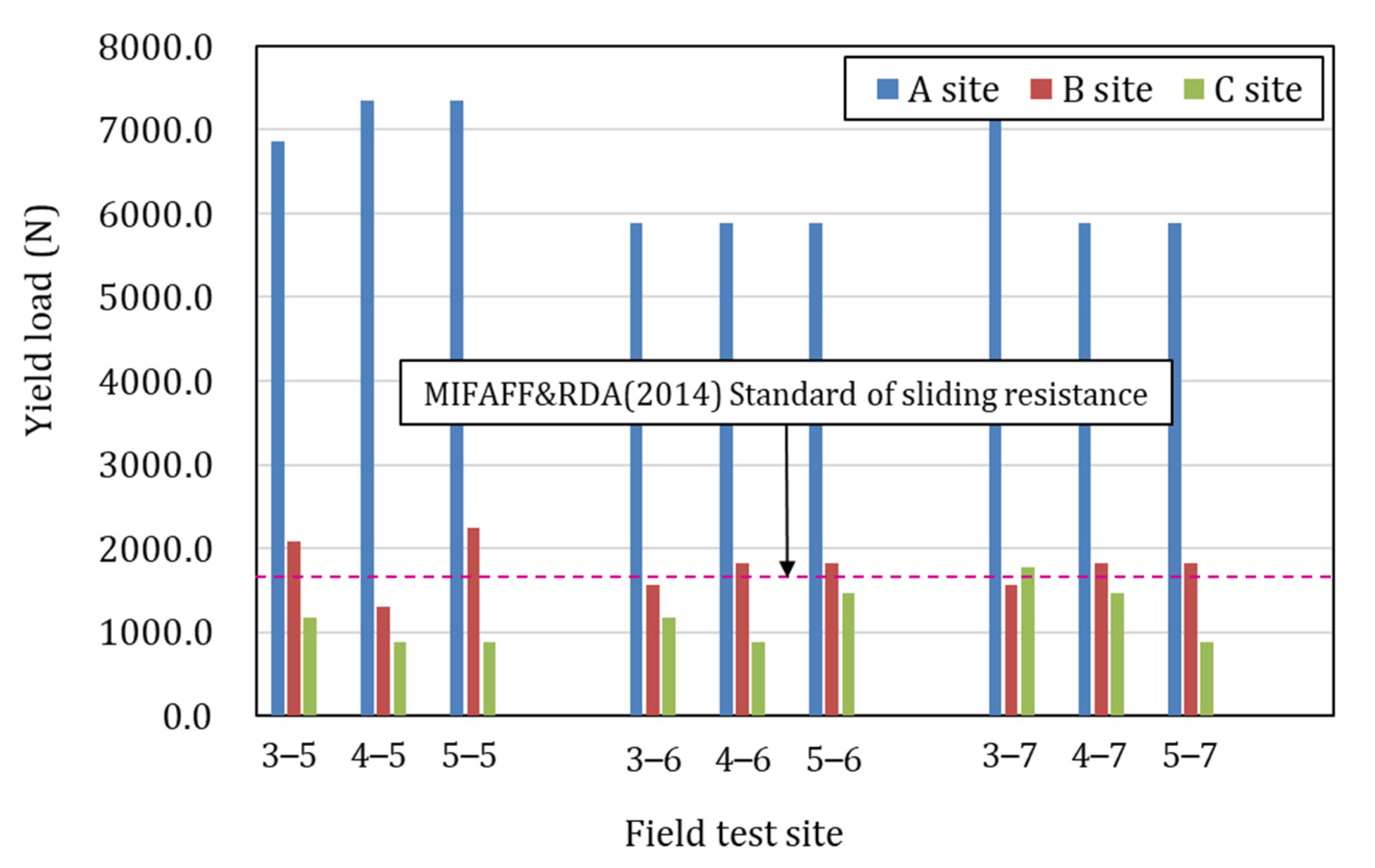

| Site | Gs | LL (%) | PI | (kN/m3) | (kN/m3) | O.M.C | 4.76 mm (%) | 1.0 mm (%) | 0.2 mm (%) | 0.075 mm (%) | 2μ (%) | USCS |
|---|---|---|---|---|---|---|---|---|---|---|---|---|
| A | 2.62 | N.P | N.P | 13.56 | 19.17 | 11.4 | 83.4 | 77.2 | 49.4 | 35.5 | 7.5 | SM |
| B | 2.66 | 39.8 | 16.3 | 12.45 | 17.29 | 16.7 | 97.9 | 94.2 | 70.9 | 42.2 | 12.2 | SC |
| C | 2.61 | N.P | N.P | 10.53 | 15.84 | 18.4 | 100 | 99.8 | 99.0 | 65.1 | 5.5 | ML |
| Type | 07-Single -Span 1~4 | 10-Single -Span 1~5 | 10-Single -Span 6~9 | 10-Single -Span 10~13 | 07-Single -Span 18 | 12-Single -Span 1 |
|---|---|---|---|---|---|---|
| Rafter spacing (mm) | 500 | 400 | 500 | 400 | 500 | 500 |
| Embedded depth (mm) | 250 | 250 | 250 | 200 | 250 | 250 |
| Site | Embedded Depth (mm) | Rafter Spacing (mm) | ||||
|---|---|---|---|---|---|---|
| 3 | 4 | 5 | 5 | 6 | 7 | |
| A, B, C | 300 | 400 | 500 | 500 | 600 | 700 |
| Site | Field Density (kN/m3) | ||||||||
|---|---|---|---|---|---|---|---|---|---|
| 3–5 | 4–5 | 5–5 | 3–6 | 4–6 | 5–6 | 3–7 | 4–7 | 5–7 | |
| A | 14.11 | 11.64 | 12.787 | 13.51 | 14.24 | 13.10 | 13.71 | 14.47 | 13.79 |
| B | 12.37 | 10.81 | 10.12 | 12.18 | 10.89 | 10.07 | 11.24 | 13.43 | 13.43 |
| C | 9.48 | 10.49 | 18.91 | 17.89 | 23.53 | 11.18 | 10.27 | 19.73 | 20.32 |
| Test Condition | Ultimate Stress (kN/m2) | Yield Stress (kN/m2) | |||||
|---|---|---|---|---|---|---|---|
| A | B | C | A | B | C | ||
| Spacing 50 cm | Depth 30 cm | 128.72 | 44.13 | 22.07 | 85.81 | 29.42 | 14.71 |
| Depth 40 cm | 137.91 | 27.59 | 16.55 | 91.94 | 18.39 | 11.03 | |
| Depth 50 cm | 137.91 | 58.50 | 16.55 | 91.94 | 31.87 | 11.03 | |
| Average | 134.85 | 43.41 | 18.391 | 89.90 | 26.560 | 12.26 | |
| Spacing 60 cm | Depth 30 cm | 110.33 | 70.40 | 22.07 | 73.55 | 22.07 | 14.71 |
| Depth 40 cm | 110.33 | 38.61 | 16.55 | 73.55 | 25.74 | 11.03 | |
| Depth 50 cm | 110.33 | 38.61 | 27.59 | 73.55 | 25.74 | 18.39 | |
| Average | 110.33 | 49.21 | 22.07 | 73.55 | 24.52 | 14.71 | |
| Spacing 70 cm | Depth 30 cm | 137.91 | 33.11 | 33.11 | 91.94 | 22.07 | 22.07 |
| Depth 40 cm | 110.33 | 38.61 | 27.59 | 73.55 | 25.74 | 18.39 | |
| Depth 50 cm | 110.33 | 38.61 | 16.55 | 73.55 | 25.74 | 11.03 | |
| Average | 119.52 | 36.78 | 25.75 | 79.68 | 24.52 | 17.16 | |
| Test Condition | Ultimate Uplift Load (N) | Yield Uplift Load (N) | |||||
|---|---|---|---|---|---|---|---|
| A | B | C | A | B | C | ||
| Interval | Depth 30 cm | 10,297.2 | 3530.4 | 1765.2 | 6864.8 | 2078.5 | 1176.8 |
| 50 cm | Depth 40 cm | 11,032.8 | 2206.8 | 1323.6 | 7355.2 | 1299.3 | 882.4 |
| Depth 50 cm | 11,032.8 | 4680.0 | 1323.6 | 7355.2 | 2251.6 | 882.4 | |
| Average | 10,787.6 | 3472.4 | 1470.8 | 7191.7 | 1876.5 | 980.5 | |
| Interval | Depth 30 cm | 8826.0 | 5632.0 | 1765.2 | 5884.0 | 1559.2 | 1176.8 |
| 60 cm | Depth 40 cm | 8826.0 | 3088.8 | 1323.6 | 5884.0 | 1818.5 | 882.4 |
| Depth 50 cm | 8826.0 | 3088.8 | 2206.8 | 5884.0 | 1818.5 | 1471.2 | |
| Average | 8826.0 | 3936.5 | 1765.2 | 5884.0 | 1732.1 | 1176.8 | |
| Interval | Depth 30 cm | 11,032.8 | 2648.4 | 2648.4 | 7355.2 | 1559.2 | 1765.6 |
| 70 cm | Depth 40 cm | 8826.0 | 3088.8 | 2206.8 | 5884.0 | 1818.5 | 1471.2 |
| Depth 50 cm | 8826.0 | 3088.8 | 1323.6 | 5884.0 | 1818.5 | 882.4 | |
| Average | 9561.6 | 2942.0 | 2059.6 | 6374.4 | 1732.1 | 1373.1 | |
| Standard deviation. P | 1027.4 | 999.5 | 465.5 | 684.9 | 267.9 | 310.3 | |
| No. | Ultimate Uplift Capacity (N) | |
|---|---|---|
| Steel Wire | Steel Plate | |
| 1 | 198.0 | 1441.0 |
| 2 | 175.0 | 1763.0 |
| Average | 186.0 | 1602.0 |
Publisher’s Note: MDPI stays neutral with regard to jurisdictional claims in published maps and institutional affiliations. |
© 2022 by the author. Licensee MDPI, Basel, Switzerland. This article is an open access article distributed under the terms and conditions of the Creative Commons Attribution (CC BY) license (https://creativecommons.org/licenses/by/4.0/).
Share and Cite
Kim, M. Effects of Uplift Resistance on Continuous-Pipe-Foundation of Single-Span Plastic Greenhouse by Steel Plate Pipe Connector. Agriculture 2022, 12, 1998. https://doi.org/10.3390/agriculture12121998
Kim M. Effects of Uplift Resistance on Continuous-Pipe-Foundation of Single-Span Plastic Greenhouse by Steel Plate Pipe Connector. Agriculture. 2022; 12(12):1998. https://doi.org/10.3390/agriculture12121998
Chicago/Turabian StyleKim, Myeonghwan. 2022. "Effects of Uplift Resistance on Continuous-Pipe-Foundation of Single-Span Plastic Greenhouse by Steel Plate Pipe Connector" Agriculture 12, no. 12: 1998. https://doi.org/10.3390/agriculture12121998








